How to Engineer a Revision
 |
| Step One: Divide Points of View |
In my current WIP, I am working with two distinct points of
view moving through simultaneous timelines against a hefty historical event.
The challenge is making these points of view distinct without compromising either
timeline, while still making sure that
the event – a coming together of complex social and political systems – is easy enough for young readers to follow.
Easy peasy lemon squeezy.
Not.
So how does one weave together all of these elements into a
cohesive story? I first came upon the term “story engineering” in Larry Brooks’
excellent book, Story Engineering: Mastering the 6 Core Competencies of
Successful Writing (Writers Digest Books, 2011). Story engineering is not just
about planning or outlining, but certainly that’s a part of the process. In the
same way that engineers rely on blueprints to create a structure that bears
weight and resists the elements, writers arm themselves with a strategy to
create an equally structurally sound foundation upon which the literary
elements may rest. It's also a good approach as one begins the revision process..
Looking for information on how to engineer two points of
view at once, I went to my go-to for information on writing strategies. Lorin
Oberweger’s Free Expressions Seminars .
And –of course – I found the perfect workshop: Non-Linear,
Dual-Timeline, And Multiple POV Plotting with Donald Maass. No one does it
better than Donald Maass. During the almost two-hour workshop, Donald offered
step-by-step instruction, citing examples from ‘break-out’ fiction to support
his process.
Returning to my WIP, I begin to engineer my two points of
view and their plotlines. (This is a basic step-by- step that fits my particular
narrative. For more information, especially as it relates to your project, you
really really do need to check out Donald Maass’ workshops at Free Expressions.)
1. I divide the draft by points of view. It’s like having two separate stories. The parallel narratives need to be so tight, and so relevant, that one cannot exist without the other. While the two points of view need to be pronounced, and distinct, they need to be connected by theme.
2. I review the carryovers (transitions) between chapters to make sure the story of each point of view flow.
3. I review both timelines to make sure the scenes connected to the broader plot. This includes adding research as needed to make sure each scene is complete.
 |
| Step Four: Combine the Points of View |
4. I then combine the two points of view into one story, aligning the events to strengthen the timeline and reinforce the causal chain. This means quickly establishing the narrative pattern, in which the points of view shift between the characters. It also means noting where additional chapters might be needed to complete the timeline.
5. To keep the reader oriented, I review each points of view to make sure the characters are distinct, reinforcing certain literary devices. These devices include vocabulary, sensibilities (world views), personality traits, and specific artifacts (such as diaries, pets or songs!).
I'm impressed! Harold
ReplyDeleteThank you for crystallizing the process of managing multiple timelines and POVs. I write environmental fiction and climate fiction impacting diverse characters and places around the globe, which entails weaving them all together.
ReplyDeleteSuper useful content, Bobbi!
ReplyDelete